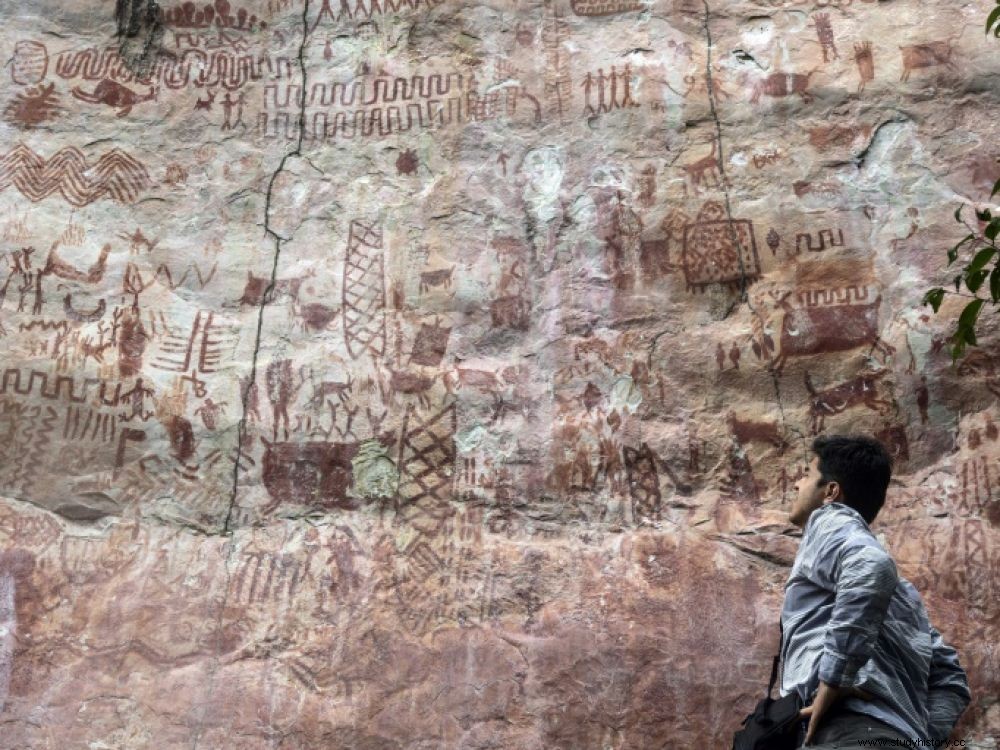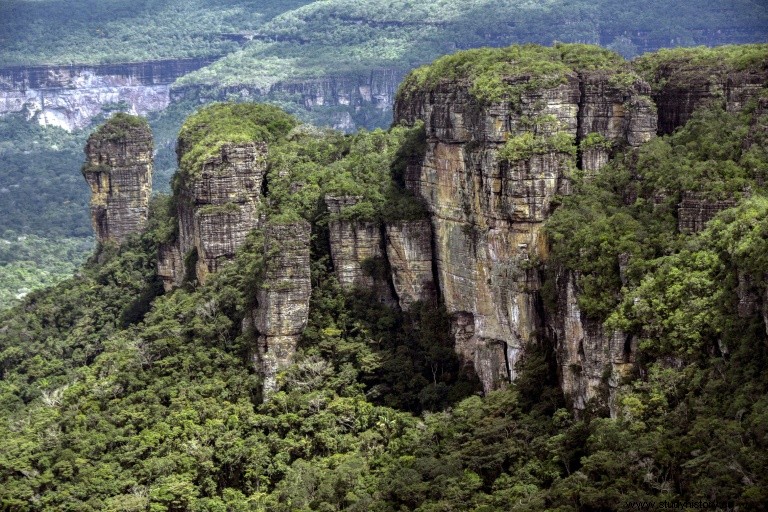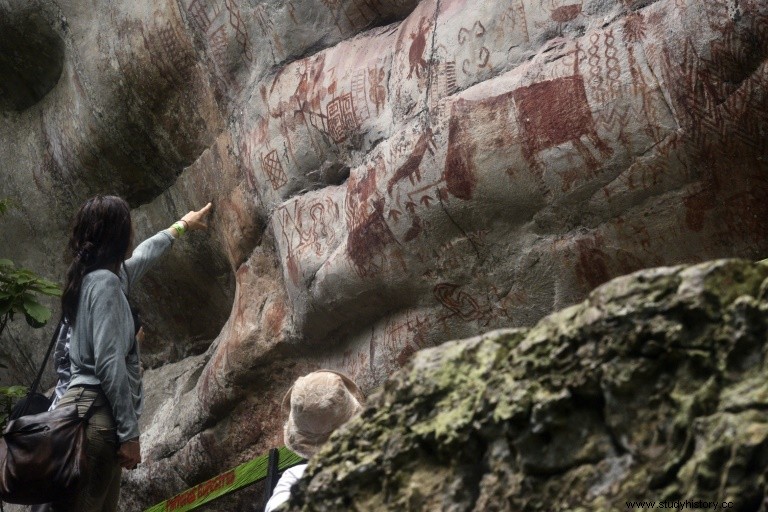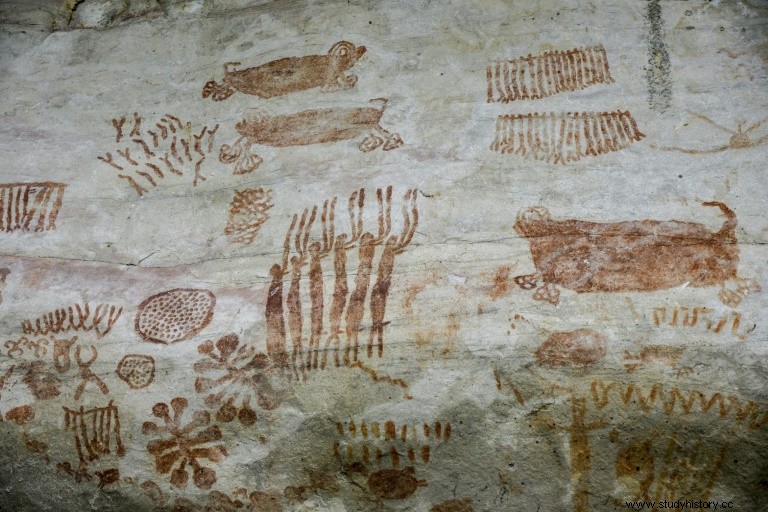For millennia, the natives of Colombia have illustrated their mythology in the jungle of Guaviare, a treasure that remained inaccessible during decades of war.

Andrés Lopez, historian of the Colombian Institute of Anthropology and History (ICANH) in front of a rock panel painted more than 100 meters long and 30 high, in the park of Serrania de la Lindosa, in the jungle of the Guaviare.
In the dense humidity of the Amazon, at the turn of a steep path, a gigantic painted rock face:anacondas, jaguars, turtles... For millennia, the natives of Colombia have illustrated their mythology there, a treasure that has remained inaccessible for centuries. decades of war. In the heart of the Guaviare jungle, a strategic area of the conflict over which armed groups are still vying for control, stand the tepuys of the Chiribiquete and Serrania de la Lindosa natural park, eroded mountains from the Tertiary era, resembling giant drums. Scattered across the emerald green ocean of southern Colombia, in a territory almost the size of Switzerland, they shelter hundreds of rock frescoes against their sides, of inestimable value for understanding the settlement of the Amazon. "Working in Guaviare was very complicated because it was the epicenter (...) of the war for the last fifty years (...). Although there were exploration missions at the beginning of the 20th century, they ceased because of the situation" , explained to AFP Ernesto Montenegro, director general of the Colombian Institute of Anthropology and History (ICANH).

Aerial view of the Serrania de Chiribiquete National Park, June 7, 2018 in Colombia © AFP - GUILLERMO LEGARIA
Thanks to the 2016 peace agreement with the Farc guerrillas, researchers are once again venturing to the tepuys to decipher these ritual petroglyphs, drawings affixed to the rock by Amazonian peoples for at least 12,000 years. And still today.
Territory of spirits
But not every native has access to it. "Only the wise are able to enter these sacred sites, populated by spirits. Ordinary mortals should not even travel there by thought" , adds Andrés Lopez, ICANH historian, while climbing through the mud to a painted rock panel more than 100 meters long and 30 high, in the Serrania de la Lindosa, an hour's drive by 4x4 of Raudal. This village in the municipality of San José del Guaviare, where coca plantations and the manufacture of cocaine are law, marked the dividing line between the Revolutionary Armed Forces of Colombia (Farc) and the police.

Céline Valadeau, IFEA anthropologist attached to the French Ministry of Foreign Affairs examines rock pictographs on June 8, 2018 in the Colombian jungle of Guaviare (AFP - GUILLERMO LEGARIA)
One hour by boat on the Guaviare, a tumultuous tributary of the Orinoco still traveled by military launches equipped with machine guns, this hamlet on stilts, also surrounded by far-right paramilitaries until the 2000s, remains the stronghold of the Premier Front, dissident of the former guerrillas, which refused to demobilize. However, "today we return to Guaviare" , rejoices Mr. Montenegro, explaining other frescoes, further on the Cerro Azul, happy that the archaeologists have "benefited from the peace process" because the situation despite everything is calming down. The dissidents of the Farc, if they inspect the explorers, delimit a perimeter for them, seem not to oppose the study of a cultural heritage still very little known.
Sites to discover
At the end of May, the Serrania de la Lindosa was declared an "Archaeological Protected Area" by the Ministry of Culture, on the initiative of ICANH, also at the origin of the first international mission to the site, in cooperation with the French Institute of Andean Studies (IFEA).

Rock pictographs in the Serrania La Lindosa park, June 8, 2018 in the Colombian jungle of Guaviare © AFP - GUILLERMO LEGARIA
"We hope to do (...) work that can explain all this. There is still a lot to discover!" , specifies Céline Valadeau, anthropologist of the IFEA, attached to the French Ministry of Foreign Affairs. In addition to sites still unknown, there are some of which "there is photographic evidence (...) but which it has not been possible to find because at the time there was no of GPS" and the cartographic surveys are imprecise, she adds, in front of pictograms of dancers, hunters and even romantic relationships.
Made from a mineral mixture rich in manganese, which when oxidized gives them an orange color, the paints are impossible to date, including carbon 14 for lack of plant components. The only clues lie in the remains of fires lit by the artists at the foot of the walls. As for Chiribiquete, whose immensity overflown by plane amazes even seasoned experts, the first archaeological research began there in the 1980s and 1990s. Just before the worst time of the war.
Today, in order to preserve it from mining and oil covetousness, the ICANH has managed a request for classification as a UNESCO World Heritage Site. The verdict is expected at the end of June. This park, which contains no less than 70,000 pictograms, could become the 9th Colombian site on this prestigious list, but the first pre-Columbian marvel classified on the planet. A few days before the presidential election on June 17, Mr. Montenegro hopes that these treasures will be preserved:"Whoever is the president, he must have as his horizon this territory made up of enormous cultural riches" .
